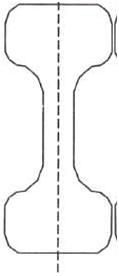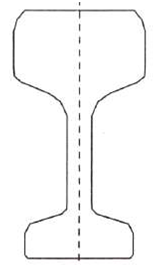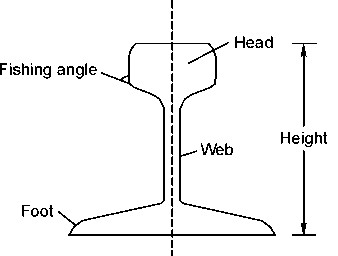Rails are the members of the track laid in two parallel lines to provide an unchanging, continuous, and level surface for the movement of trains. To be able to withstand stresses, they are made of high-carbon steel. Standard rail sections, their specifications, and various types of rail defects are discussed in this section.
FUNCTION OF RAILS
Rails are similar to steel girders. They perform the following functions in a track:
(a) Rails provide a continuous and level surface for the movement of trains.
(b) They provide a pathway which is smooth and has very little friction. The friction between the steel wheel and the steel rail is about one-fifth of the friction between the pneumatic tyre and a metalled road.
(c) They serve as a lateral guide for the wheels.
(d) They bear the stresses developed due to vertical loads transmitted to them through axles and wheels of rolling stock as well as due to braking and thermal forces.
(e) They carry out the function of transmitting the load to a large area of the formation through sleepers and the ballast.
TYPES OF RAILS
DOUBLE HEADED RAIL
The first rails used were double headed ( DH) and made of an I or dumb bell section. The idea was that once the head wore out during service ,the rail could be inverted and reused. experience however showed that while in service the bottom table of the rail was dented to such an extent because of long and continuous contact with the chair that it was not possible to reuse it.

BULL HEADED RAIL
It had an almost similar shape but with more metal in the head to better withstand wear and tear. The rail section had the major drawback that chairs were required for fixing it to the sleepers.

FLAT-FOOTED RAIL
A flat footed rails also called a vignole rail with an inverted T-type cross section of inverted T-type was, therefore, developed which could be fixed directly to the sleepers with the help of spikes and it more economical also.

REQUIREMENTS OF AN IDEAL RAIL SECTION
The requirements of an ideal rail section are as follows:
(a) The rail should have the most economical section consistent with strength, stiffness, and durability.
(b) The centre of gravity of the rail section should preferably be very close to the mid-height of the rail so that the maximum tensile and compressive stresses are equal.
(c) A rail primarily consists of a head, a web, and a foot, and there should be an economical and balanced distribution of metal in its various components so that each of them can fulfil its requirements properly.
The requirements, as well as the main considerations, for the design of these rail components are as follows:
Head The head of the rail should have adequate depth to allow for vertical wear. The rail head should also be sufficiently wide so that not only is a wider running surface available, but also the rail has the desired lateral stiffness. Web The web should be sufficiently thick so as to withstand the stresses arising due to the loads bore by it, after allowing for normal corrosion.
Foot The foot should be of sufficient thickness to be able to withstand vertical and horizontal forces after allowing for loss due to corrosion. The foot should be wide enough for stability against overturning. The design of the foot should be such that it can be economically and efficiently rolled.
Fishing angles These must ensure proper transmission of loads from the rails to the fish plates. The fishing angles should be such that the tightening of the plate does not produce any excessive stress on the web of the rail.
Height of the rail The height should be adequate so that the rail has sufficient vertical stiffness and strength as a beam.
Weight of rails
Though the weights of a rail and its section depend upon various considerations, the heaviest axle load that the rail has to carry loads the most important role. The following is the thumb rule for defining the maximum axle load with relation to the rail section:
Maximum axle load = 560 x sectional weight of rail in Ibs per yard or kg per metre
- For rails of 90 Ibs per yard,
* Under revision
Maximum axle load = 560 x 90 Ibs = 50,400 Ibs or 22.5 tonnes
- For rails of 52 kg per m,
Maximum axle load = 560 x 52 kg = 29.12 tonnes
- For rail of 60 kg per m,
Max. axle load for 60 kg/m rail = 560 x 60 kg = 33.60 tonnes
Length of rails
Theoretically, the longer is the rail, the lesser would be the number of joints and fittings required and the lesser the cost of construction and maintenance. Longer rails are economical and provide smooth and comfortable rides. The length of a rail is, however, restricted due to the following factors:
(a) Lack of facilities for transport of longer rails, particularly on curves
(b) Difficulties in manufacturing very long rails
(c) Difficulties in acquiring bigger expansion joints for long rails
(d) Heavy internal thermal stresses in long rails
Taking the above factors into consideration, Indian Railways has standardized a rail length of 13 m (previously 42 ft) for broad gauge and 12 m (previously 39 ft) for MG and NG tracks. Indian Railways is also planning to use 39 m, and even longer rails in its track system. Now 65 m/78 m long rails are being produced at SAIL, Bhilai and it is planned to manufacture 130 m long rails.